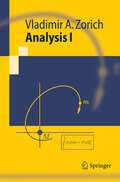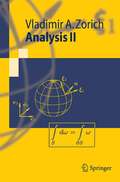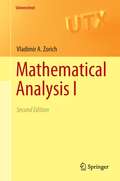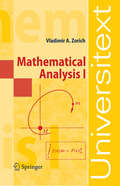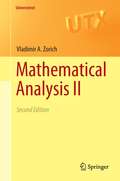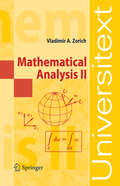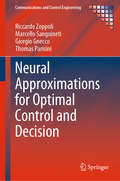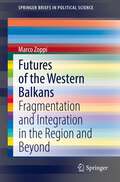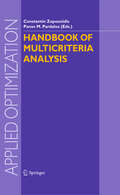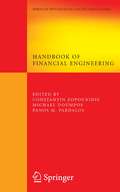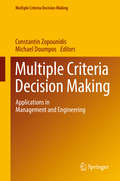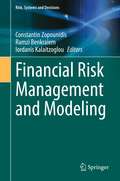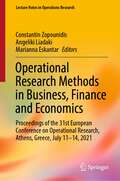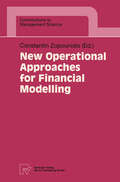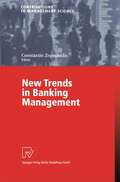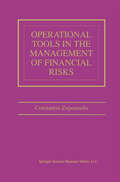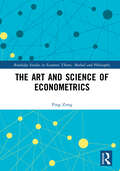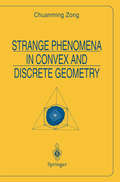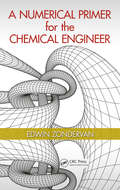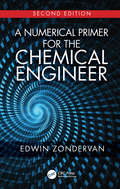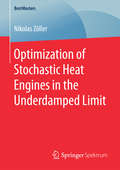- Table View
- List View
Analysis 1 (Springer-Lehrbuch)
by V. A. ZorichAusführlicher Einblick in die Anfänge der Analysis: von der Einführung der reellen Zahlen bis hin zu fortgeschrittenen Themen wie Differentialformen auf Mannigfaltigkeiten, asymptotische Betrachtungen, Fourier-, Laplace- und Legendre-Transformationen, elliptische Funktionen und Distributionen. Ausgerichtet auf naturwissenschaftliche Fragestellungen und in detaillierter Herangehensweise an die Integral- und Differentialrechnung. Mit einer Fülle hilfreicher Beispiele, Aufgaben und Anwendungen. In Band 1: vollständige Übersicht zur Integral- und Differentialrechnung einer Variablen, erweitert um die Differentialrechnung mehrerer Variablen.
Analysis II (Springer-Lehrbuch)
by V. A. ZorichDieses zweibändige Werk bietet einen ausführlichen und tiefgehenden Einblick in die Anfänge der Analysis: von der Einführung der reellen Zahlen bis hin zu fortgeschrittenen Themen wie Differentialformen auf Mannigfaltigkeiten, asymptotische Betrachtungen, Fourier-, Laplace- und Legendre-Transformationen, elliptische Funktionen und Distributionen. Besonders hervorzuheben ist dabei die deutliche Ausrichtung auf naturwissenschaftliche Fragestellungen und die detaillierte Herangehensweise an die wichtigen Begriffe, Inhalte und Sätze der Integral- und Differentialrechnung. Eine Fülle hilfreicher Beispiele, Aufgaben und Anwendungen, die selten in Analysisbüchern zu finden sind, ergänzt die Klarheit und Exaktheit der Präsentation. Im zweiten Band wird der heutige Stand klassischer Analysis erläutert, als Bestandteil einer vereinheitlichten Mathematik und ihrer Interaktion mit modernen mathematischen Lehrveranstaltungen wie der Algebra, der Differentialgeometrie, den Differentialgleichungen, der komplexen und der Funktionalanalysis. Das Buch legt für fortgeschrittene Studien in jede dieser Richtungen ein solides Fundament.
Mathematical Analysis I (Universitext)
by V. A. ZorichThis second edition of a very popular two-volume work presents a thorough first course in analysis, leading from real numbers to such advanced topics as differential forms on manifolds; asymptotic methods; Fourier, Laplace, and Legendre transforms; elliptic functions; and distributions. Especially notable in this course are the clearly expressed orientation toward the natural sciences and the informal exploration of the essence and the roots of the basic concepts and theorems of calculus. Clarity of exposition is matched by a wealth of instructive exercises, problems, and fresh applications to areas seldom touched on in textbooks on real analysis. The main difference between the second and first editions is the addition of a series of appendices to each volume. There are six of them in the first volume and five in the second. The subjects of these appendices are diverse. They are meant to be useful to both students (in mathematics and physics) and teachers, who may be motivated by different goals. Some of the appendices are surveys, both prospective and retrospective. The final survey establishes important conceptual connections between analysis and other parts of mathematics. The first volume constitutes a complete course in one-variable calculus along with the multivariable differential calculus elucidated in an up-to-date, clear manner, with a pleasant geometric and natural sciences flavor.
Mathematical Analysis I (Universitext)
by V. A. ZorichThis softcover edition of a very popular two-volume work presents a thorough first course in analysis, leading from real numbers to such advanced topics as differential forms on manifolds, asymptotic methods, Fourier, Laplace, and Legendre transforms, elliptic functions and distributions. Especially notable in this course is the clearly expressed orientation toward the natural sciences and its informal exploration of the essence and the roots of the basic concepts and theorems of calculus. Clarity of exposition is matched by a wealth of instructive exercises, problems and fresh applications to areas seldom touched on in real analysis books. The first volume constitutes a complete course on one-variable calculus along with the multivariable differential calculus elucidated in an up-to-day, clear manner, with a pleasant geometric flavor.
Mathematical Analysis II (Universitext)
by V. A. ZorichThis second English edition of a very popular two-volume work presents a thorough first course in analysis, leading from real numbers to such advanced topics as differential forms on manifolds; asymptotic methods; Fourier, Laplace, and Legendre transforms; elliptic functions; and distributions. Especially notable in this course are the clearly expressed orientation toward the natural sciences and the informal exploration of the essence and the roots of the basic concepts and theorems of calculus. Clarity of exposition is matched by a wealth of instructive exercises, problems, and fresh applications to areas seldom touched on in textbooks on real analysis.The main difference between the second and first English editions is the addition of a series of appendices to each volume. There are six of them in the first volume and five in the second. The subjects of these appendices are diverse. They are meant to be useful to both students (in mathematics and physics) and teachers, who may be motivated by different goals. Some of the appendices are surveys, both prospective and retrospective. The final survey establishes important conceptual connections between analysis and other parts of mathematics. This second volume presents classical analysis in its current form as part of a unified mathematics. It shows how analysis interacts with other modern fields of mathematics such as algebra, differential geometry, differential equations, complex analysis, and functional analysis. This book provides a firm foundation for advanced work in any of these directions.
Mathematical Analysis II (Universitext)
by V. A. ZorichAn entire generation of mathematicians has grown up during the time - tween the appearance of the ?rst edition of this textbook and the publication of the fourth edition, a translation of which is before you. The book is fam- iar to many people, who either attended the lectures on which it is based or studied out of it, and who now teach others in universities all over the world. I am glad that it has become accessible to English-speaking readers. This textbook consists of two parts. It is aimed primarily at university students and teachers specializing in mathematics and natural sciences, and at all those who wish to see both the rigorous mathematical theory and examplesofitse?ectiveuseinthesolutionofrealproblemsofnaturalscience. The textbook exposes classical analysis as it is today, as an integral part of Mathematics in its interrelations with other modern mathematical courses such as algebra, di?erential geometry, di?erential equations, complex and functional analysis.
Neural Approximations for Optimal Control and Decision (Communications and Control Engineering)
by Riccardo Zoppoli Marcello Sanguineti Giorgio Gnecco Thomas ParisiniNeural Approximations for Optimal Control and Decision provides a comprehensive methodology for the approximate solution of functional optimization problems using neural networks and other nonlinear approximators where the use of traditional optimal control tools is prohibited by complicating factors like non-Gaussian noise, strong nonlinearities, large dimension of state and control vectors, etc. Features of the text include: • a general functional optimization framework; • thorough illustration of recent theoretical insights into the approximate solutions of complex functional optimization problems; • comparison of classical and neural-network based methods of approximate solution; • bounds to the errors of approximate solutions; • solution algorithms for optimal control and decision in deterministic or stochastic environments with perfect or imperfect state measurements over a finite or infinite time horizon and with one decision maker or several; • applications of current interest: routing in communications networks, traffic control, water resource management, etc.; and • numerous, numerically detailed examples. The authors’ diverse backgrounds in systems and control theory, approximation theory, machine learning, and operations research lend the book a range of expertise and subject matter appealing to academics and graduate students in any of those disciplines together with computer science and other areas of engineering.
Futures of the Western Balkans: Fragmentation and Integration in the Region and Beyond (SpringerBriefs in Political Science)
by Marco ZoppiThis Brief provides a survey of key political, social, and economic issues affecting the Western Balkans region. Taking a two-pronged conceptual approach focusing on fragmentation and integration, the volume highlights commonalities and differences in a number of simultaneous dynamics currently characterizing the region: Europeanization and EU access, market integration, and migration and socio-demographic transformations. Stressing the interconnectedness of these issues, the volume synthesizes key questions for the future of the region, such as the relationship between socio-demographic trends and economic development, the effects of depopulation on further EU integration, and the economic and political repercussions of enhanced intra-regional trade. Explicitly interdisciplinary, this Brief will be useful for researchers and students specializing in the Balkans and Western Balkans, post-socialist countries, European affairs, enlargement, foreign policy, international relations, regional studies, economics, economic transition, and socio-demographics.
Handbook of Multicriteria Analysis (Applied Optimization #103)
by Constantin Zopounidis Panos M. PardalosMulticriteria analysis is a rapidly growing aspect of operations research and management science, with numerous practical applications in a wide range of fields. This book presents all the recent advances in multicriteria analysis, including multicriteria optimization, goal programming, outranking methods, and disaggregation techniques. The latest developments on robustness analysis, preference elicitation, and decision making when faced with incomplete information, are also discussed, together with applications in business performance evaluation, finance, and marketing. Finally, the interactions of multicriteria analysis with other disciplines are also explored, including among others data mining, artificial intelligence, and evolutionary methods.
Handbook of Financial Engineering (Springer Optimization and Its Applications #18)
by Constantin Zopounidis Michael Doumpos Panos M. PardalosThis comprehensive handbook discusses the most recent advances within the field of financial engineering, focusing not only on the description of the existing areas in financial engineering research, but also on the new methodologies that have been developed for modeling and addressing financial engineering problems. The book is intended for financial engineers, researchers, applied mathematicians, and graduate students interested in real-world applications to financial engineering.
Multiple Criteria Decision Making: Applications in Management and Engineering (Multiple Criteria Decision Making)
by Constantin Zopounidis Michael DoumposThis book presents a broad range of innovative applications and case studies in all areas of management and engineering, including public administration, finance, marketing, engineering, transportation, and energy systems. It addresses issues related to problem structuring, preference modeling, and model construction, presenting a framework that provides clear decision-making support in practice. In addition, it includes hybrid and integrated techniques combining multiple criteria decision making (MCDM) with other analytical methods. The book reflects the growing impact of MCDM in the field of management science and operations research. Building on recent and established theoretical advances and presenting their applications in specific domains, it offers a comprehensive resource for researchers, graduate students and professionals alike.
Financial Risk Management and Modeling (Risk, Systems and Decisions)
by Constantin Zopounidis Ramzi Benkraiem Iordanis KalaitzoglouRisk is the main source of uncertainty for investors, debtholders, corporate managers and other stakeholders. For all these actors, it is vital to focus on identifying and managing risk before making decisions. The success of their businesses depends on the relevance of their decisions and consequently, on their ability to manage and deal with the different types of risk. Accordingly, the main objective of this book is to promote scientific research in the different areas of risk management, aiming at being transversal and dealing with different aspects of risk management related to corporate finance as well as market finance. Thus, this book should provide useful insights for academics as well as professionals to better understand and assess the different types of risk.
Operational Research Methods in Business, Finance and Economics: Proceedings of the 31st European Conference on Operational Research, Athens, Greece, July 11-14, 2021 (Lecture Notes in Operations Research)
by Constantin Zopounidis Liadaki Angeliki Eskantar MariannaThis book gathers selected high-quality papers presented at the 31st European Conference on Operational Research, which was held in Athens, Greece on June 11-14, 2021.It highlights the latest advances in the application of operations research (OR) to technology-driven areas in business, finance, and economics, covering both theoretical and methodological developments, as well as real-world case studies. It also explores the connections between OR and other analytical disciplines, such as soft computing and computer science, which can promote the development of new decision support technologies.
New Operational Approaches for Financial Modelling (Contributions to Management Science)
by Constantin Zopounidisth This book is devoted to the 19 Meeting of the EURO Working Group on Financial Modelling, held in Chania, Crete, Greece,November28-30, 1996. The EURO Working Group on Financial Modelling was founded in September 1986 in Lisbon. The primary field of interest for the Working Group can be described as "the development of financial models that help to solve problems facedby financial managers in the firm". From this point of view, the following objectivesof the Working Group are distinguished: • providing an international forum for exchange of information and experience on financial modelling; • encouraging research in financial modelling (i. e. new techniques, methodologies, software,empirical studies,etc. ); • stimulating and strengthening the interaction between financial economic theory and the practice of financial decision making; • cooperating and exchanging information with universities and financial institutions throughout Europe. According to the aboveobjectives,the basic aim of this book is to present some new operational approaches (i. e. neural nets, multicriteria analysis, new optimization algorithms, decision software, etc. ) for financial modelling, both in a theoretical and practical levels. Thus, the present volume is divided in nine chapters. The first chapter refers to the new trends in financial modelling and includes two invited papers by Gil-Aluja and Pardalos. The second chapter involves papers on the topic of high performance computing and finance which is a European union project in which participate some members of the EURO Working Group on Financial Modelling (Spronk, Zenios, Dempster, etc. ).
New Trends in Banking Management (Contributions to Management Science)
by Constantin ZopounidisDuring the last decades the globalization, the intensified competition and the rapid changes in the socio-economic and technological environment had a major impact on the global economic, financial and business environments. Within this environment, it is clear that banking institutions worldwide face new challenges and increasing risks, as well as increasing business potentials. The recent experience shows that achieving a sustainable development of the banking system is not only of interest to the banking institutions themselves, but it is also directly related to the development of the whole business and economic environment, both at regional and international level. The variety of new banking products that is constantly being developed to accommodate the increased customer needs (firms, organizations, individuals, etc.) provides a clear indication of the changes that the banking industry has undergone during the last two decades. The establishment of new products of innovative processes and instruments for their requires the implementation efficient management. The implementation of such processes and instruments is closely related to a variety of disciplines, advanced quantitative analysis for risk management, information technology, quality management, etc. The implementation ofthese approaches in banking management is in accordance with the finding that empirical procedures are no longer adequate to address the increasing complexity of the banking industry.
Operational Tools in the Management of Financial Risks
by Constantin ZopounidisThis book presents a set of new, innovative mathematical modeling tools for analyzing financial risk. Operational Tools in the Management of Financial Risks presents an array of new tools drawn from a variety of research areas, including chaos theory, expert systems, fuzzy sets, neural nets, risk analysis, stochastic programming, and multicriteria decision making. Applications cover, but are not limited to, bankruptcy, credit granting, capital budgeting, corporate performance and viability, portfolio selection/management, and country risk. The book is organized into five sections. The first section applies multivariate data and multicriteria analyses to the problem of portfolio selection. Articles in this section combine classical approaches with newer methods. The second section expands the analysis in the first section to a variety of financial problems: business failure, corporate performance and viability, bankruptcy, etc. The third section examines the mathematical programming techniques including linear, dynamic, and stochastic programming to portfolio managements. The fourth section introduces fuzzy set and artificial intelligence techniques to selected types of financial decisions. The final section explores the contribution of several multicriteria methodologies in the assessment of country financial risk. In total, this book is a systematic examination of an emerging methodology for managing financial risk in business.
The Art and Science of Econometrics (Routledge Studies in Economic Theory, Method and Philosophy)
by Ping ZongToday econometrics has been widely applied in the empirical study of economics. As an empirical science, econometrics uses rigorous mathematical and statistical methods for economic problems. Understanding the methodologies of both econometrics and statistics is a crucial departure for econometrics. The primary focus of this book is to provide an understanding of statistical properties behind econometric methods. Following the introduction in Chapter 1, Chapter 2 provides the methodological review of both econometrics and statistics in different periods since the 1930s. Chapters 3 and 4 explain the underlying theoretical methodologies for estimated equations in the simple regression and multiple regression models and discuss the debates about p-values in particular. This part of the book offers the reader a richer understanding of the methods of statistics behind the methodology of econometrics. Chapters 5–9 of the book are focused on the discussion of regression models using time series data, traditional causal econometric models, and the latest statistical techniques. By concentrating on dynamic structural linear models like state-space models and the Bayesian approach, the book alludes to the fact that this methodological study is not only a science but also an art. This work serves as a handy reference book for anyone interested in econometrics, particularly in relevance to students and academic and business researchers in all quantitative analysis fields.
The Art and Science of Econometrics (Routledge Studies in Economic Theory, Method and Philosophy)
by Ping ZongToday econometrics has been widely applied in the empirical study of economics. As an empirical science, econometrics uses rigorous mathematical and statistical methods for economic problems. Understanding the methodologies of both econometrics and statistics is a crucial departure for econometrics. The primary focus of this book is to provide an understanding of statistical properties behind econometric methods. Following the introduction in Chapter 1, Chapter 2 provides the methodological review of both econometrics and statistics in different periods since the 1930s. Chapters 3 and 4 explain the underlying theoretical methodologies for estimated equations in the simple regression and multiple regression models and discuss the debates about p-values in particular. This part of the book offers the reader a richer understanding of the methods of statistics behind the methodology of econometrics. Chapters 5–9 of the book are focused on the discussion of regression models using time series data, traditional causal econometric models, and the latest statistical techniques. By concentrating on dynamic structural linear models like state-space models and the Bayesian approach, the book alludes to the fact that this methodological study is not only a science but also an art. This work serves as a handy reference book for anyone interested in econometrics, particularly in relevance to students and academic and business researchers in all quantitative analysis fields.
Sphere Packings (Universitext)
by Chuanming ZongSphere packings is one of the most fascinating and challenging subjects in mathematics. In the course of centuries, many exciting results have been obtained, ingenious methods created, related challenging problems proposed, and many surprising connections with other subjects found. This book gives a full account of this fascinating subject, especially its local aspects, discrete aspects, and its proof methods. The book includes both classical and contemporary results and provides a full treatment of the subject.
Strange Phenomena in Convex and Discrete Geometry (Universitext)
by Chuanming ZongConvex and discrete geometry is one of the most intuitive subjects in mathematics. One can explain many of its problems, even the most difficult - such as the sphere-packing problem (what is the densest possible arrangement of spheres in an n-dimensional space?) and the Borsuk problem (is it possible to partition any bounded set in an n-dimensional space into n+1 subsets, each of which is strictly smaller in "extent" than the full set?) - in terms that a layman can understand; and one can reasonably make conjectures about their solutions with little training in mathematics.
A Numerical Primer for the Chemical Engineer
by Edwin ZondervanSolve Developed Models in a Numerical FashionDesigned as an introduction to numerical methods for students, A Numerical Primer for the Chemical Engineer explores the role of models in chemical engineering. Combining mathematical correctness (model verification) with numerical performance (model validation), this text concentrates on numerical metho
A Numerical Primer for the Chemical Engineer, Second Edition
by Edwin ZondervanDesigned as an introduction to numerical methods for students, this book combines mathematical correctness with numerical performance, and concentrates on numerical methods and problem solving. It applies actual numerical solution strategies to formulated process models to help identify and solve chemical engineering problems. Second edition comes with additional chapter on numerical integration and section on boundary value problems in the relevant chapter. Additional material on general modelling principles, mass/energy balances and separate section on DAE’s is also included. Case study section has been extended with additional examples.
A Numerical Primer for the Chemical Engineer, Second Edition
by Edwin ZondervanDesigned as an introduction to numerical methods for students, this book combines mathematical correctness with numerical performance, and concentrates on numerical methods and problem solving. It applies actual numerical solution strategies to formulated process models to help identify and solve chemical engineering problems. Second edition comes with additional chapter on numerical integration and section on boundary value problems in the relevant chapter. Additional material on general modelling principles, mass/energy balances and separate section on DAE’s is also included. Case study section has been extended with additional examples.
Längenkonzepte von Kindern im Elementarbereich
by Johanna ZöllnerDer alltägliche Umgang mit Längen spielt für Kinder im Elementarbereich eine bedeutende Rolle und birgt reiches mathematisches Förderpotenzial. Dennoch stehen Längen selten im Fokus der frühen mathematischen Bildung. Johanna Zöllner entwickelt auf theoretischer und empirischer Basis ein Modell, das Längenkonzepte als komplexes Zusammenspiel vielfältiger Komponenten beschreibt, die im mentalen sowie im handelnden Umgang mit Längen zum Tragen kommen. Ein umfassendes Verständnis dieser Komponenten ist grundlegend für eine adäquate Unterstützung der Kinder beim Aufbau von Längenkonzepten. Die Studie bietet wertvolle Erkenntnisse für die Gestaltung von Lehr- und Lernumgebungen, zudem eröffnen detaillierte Auswertungskategorien Diagnosemöglichkeiten und bilden eine Basis für die weitere wissenschaftliche Auseinandersetzung mit Größenkonzepten.
Optimization of Stochastic Heat Engines in the Underdamped Limit (BestMasters)
by Nikolas ZöllerNikolas Zöller examines the working principles and the underlying theoretical foundations of a microscopic heat engine. In particular, he investigates the system’s stochastic dynamics in the underdamped regime which has hardly been studied in the past, but will be experimentally feasible in the near future due to recent technological developments. Emphasis is put on the maximization of the engine’s efficiency at maximum power through optimization of the driving protocol. In addition, possible experimental realizations of a microscopic heat engine are discussed.
